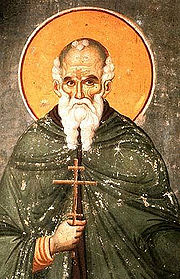
Athanasius the Athonite
Encyclopedia

Byzantine Empire
The Byzantine Empire was the Eastern Roman Empire during the periods of Late Antiquity and the Middle Ages, centred on the capital of Constantinople. Known simply as the Roman Empire or Romania to its inhabitants and neighbours, the Empire was the direct continuation of the Ancient Roman State...
monk who founded the monastic community on Mount Athos
Mount Athos
Mount Athos is a mountain and peninsula in Macedonia, Greece. A World Heritage Site, it is home to 20 Eastern Orthodox monasteries and forms a self-governed monastic state within the sovereignty of the Hellenic Republic. Spiritually, Mount Athos comes under the direct jurisdiction of the...
, which has since evolved into the greatest centre of Eastern Orthodox monasticism.
Born in Trebizond and patronized by Michael Maleinos
Michael Maleinos
Saint Michael Maleinos was a Byzantine monk who commanded great respect among Christians of Asia Minor. He was the brother of general Constantine Maleinos and uncle of Nikephoros Phokas, who was greatly influenced by Michael and became Byzantine emperor several years after his death...
, he studied at Constantinople
Constantinople
Constantinople was the capital of the Roman, Eastern Roman, Byzantine, Latin, and Ottoman Empires. Throughout most of the Middle Ages, Constantinople was Europe's largest and wealthiest city.-Names:...
and became famous there as Abraham, a fervent preacher who held great authority with Michael's nephew, Nicephorus Phocas. By the time Phocas ascended the imperial throne, Abraham, ill at ease with the lax morals of the monks living in the capital, changed his name to Athanasius and joined the monks at Mount Kyminas in Bithynia
Bithynia
Bithynia was an ancient region, kingdom and Roman province in the northwest of Asia Minor, adjoining the Propontis, the Thracian Bosporus and the Euxine .-Description:...
. In 958, he relocated to Mount Athos.
He helped defend the hermit
Hermit
A hermit is a person who lives, to some degree, in seclusion from society.In Christianity, the term was originally applied to a Christian who lives the eremitic life out of a religious conviction, namely the Desert Theology of the Old Testament .In the...
s, or sketes, there against the Saracen
Saracen
Saracen was a term used by the ancient Romans to refer to a people who lived in desert areas in and around the Roman province of Arabia, and who were distinguished from Arabs. In Europe during the Middle Ages the term was expanded to include Arabs, and then all who professed the religion of Islam...
s, and also started to incorporate the sketes already there into what would eventually become known as the Great Lavra
Great Lavra
This is the monastery on Mount Athos. For the monastery associated with Saint Sabbas, see Mar Saba.The Monastery of Great Lavra is the first monastery built on Mount Athos. It is located on the southeastern foot of the Mount at an elevation of 160 metres...
, which Athanasius built with the financial assistance of Nicephorus. This monastery was dedicated in 963. It is still in use today, and is often referred to by people of the area simply as "Lavra", or "The Monastery". Three other foundations followed shortly thereafter, with three of them remaining in place to the present. Athanasius met with considerable opposition from the hermits already at Mount Athos in the construction of his monasteries. They resented his intrusion, and his attempts to bring order and discipline to their lives.
Upon Nicephorus' death the enemies of Athanasios prevailed and he had to leave Athos for Cyprus
Cyprus
Cyprus , officially the Republic of Cyprus , is a Eurasian island country, member of the European Union, in the Eastern Mediterranean, east of Greece, south of Turkey, west of Syria and north of Egypt. It is the third largest island in the Mediterranean Sea.The earliest known human activity on the...
, where he lived until the new emperor, John Tzimisces, resumed the patronage of the Great Lavra and bestowed upon the monastery its first charter in 971. Athanasios, spurred by a divine vision, returned at once to Athos as an Hegumen
Hegumen
Hegumen, hegumenos, igumen, or ihumen is the title for the head of a monastery of the Eastern Orthodox Church or Eastern Catholic Churches, similar to the one of abbot. The head of a convent of nuns is called hegumenia or ihumenia . The term means "the one who is in charge", "the leader" in...
(Abbot) and introduced a typicon for cenobites, based on those compiled by Theodore Studites and Basil of Caesarea
Basil of Caesarea
Basil of Caesarea, also called Saint Basil the Great, was the bishop of Caesarea Mazaca in Cappadocia, Asia Minor . He was an influential 4th century Christian theologian...
.
He died during an accident, killed by falling masonry when the cupola
Cupola
In architecture, a cupola is a small, most-often dome-like, structure on top of a building. Often used to provide a lookout or to admit light and air, it usually crowns a larger roof or dome....
of his church collapsed. Upon his death, Athanasius was glorified as a saint
Saint
A saint is a holy person. In various religions, saints are people who are believed to have exceptional holiness.In Christian usage, "saint" refers to any believer who is "in Christ", and in whom Christ dwells, whether in heaven or in earth...
. His feast day is July 5.

